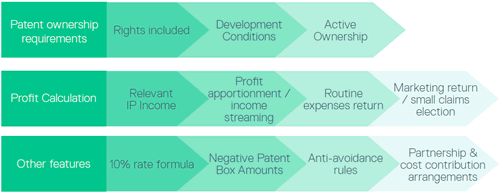UK Patent Box
Background to the Patent Box regime
August 2015
In response to high-tech company departures from the UK, the UK Government announced an initiative in 2009 called the 'Patent Box' - an effective reduction of corporation tax to 10% for income from patents. The scheme applies to the worldwide income arising from the exploitation of inventions that benefit from certain IP rights.
To be eligible for the Patent Box, a company must fulfil certain qualifying criteria, the IP rights must be 'qualifying rights' and a 'qualifying development' must be carried out in relation to the IP right. Complex calculations of qualifying profits also apply and there is a phasing in period.
Companies have been able to elect to enter the Patent Box since 1 April 2013.
Background to the Patent Box regime
The UK Government has been keen to improve the UK's competitiveness in the high-tech arena.
Companies have been able to elect to enter the Patent Box regime since 1 April 2013. Any company within the charge to UK corporation tax with income from patents (and other specified intellectual property) will, subject to phasing-in rules, potentially be able to benefit from a 10% effective rate of corporation tax. The regime is intended to apply to the worldwide income arising from the exploitation of inventions which benefit from a qualifying patent.
The phasing-in rules mean that the full benefit of the 10% effective rate will be phased in over five years, with 80% of the full benefit being available in 2015. The proportion of the full benefit will then increase by an additional 10% each year such that the full benefit of an effective 10% corporation tax rate on Patent Box profits will only be applicable from 1 April 2017.
We consider that the UK's Patent Box regime will be attractive to high tech and life sciences corporates and groups, particularly where such corporates and groups can also benefit from enhanced UK research and development credits and are able to manage the complexities of applying the regime.
The main concepts of the regime are summarised below:

Qualifying companies
As it is an optional regime, a company can only benefit from the Patent Box if, for an accounting period, it elects into the Patent Box regime. The election must be made in writing within two years of the end of the accounting period to which the election is intended to apply.
Once a company has made a Patent Box election, the Patent Box regime will continue to apply to the company until the election is revoked. If a company revokes a Patent Box election, it will not be able to re-enter the Patent Box regime for five years.
A company must meet one of the following conditions for the regime to apply:
- the company (at any time in the relevant accounting period) owns or licenses-in qualifying IP rights. Where IP rights are licensed, the licensing rights must be exclusive, at least as regards one or more countries and must exclude all other persons, including the person granting the licence; or
- the company previously owned or licensed-in qualifying IP rights, it has received income in respect of an event (in relation to the IP right or licence) which occurred both when the company was a qualifying company and had elected into the Patent Box regime and that income falls to be taxed in the relevant accounting period.
For group companies, the regime will only apply where, in addition to satisfying one of the above conditions, the company applying the Patent Box regime satisfies the 'active ownership' condition. The aim of the 'active ownership' condition is to ensure that passive IP holding companies within a group do not benefit from the Patent Box. To satisfy the 'active ownership' condition, the company must have either:
- carried out 'qualifying development' itself; or
- performed a 'significant amount of management activity',
in either case, in respect of all or almost all of the qualifying IP rights held by the company in the relevant accounting period. Management activity includes formulating plans and making decisions in relation to the development or exploitation of the IP rights.
These rules apply to all arrangements entered into by 30 June 2016. However, for all new arrangements from 1 July 2016 (and for existing arrangements from 1 July 2021), in order to benefit from the Patent Box regime, it will also be necessary for the company applying the Patent Box regime to meet the "modified nexus approach". This approach requires tax benefits under preferential IP regimes to be connected directly to research and development expenditures. Consequently for UK companies which acquire patented IP or receive an exclusive licence of patented IP on or after 1 July 2016, it is anticipated that substantial activity (in the form of research and development investment) will need to be undertaken by the UK company owning the IP in order to benefit from the Patent Box relief.
There are also rules allowing certain partnerships and cost sharing arrangements to qualify for the Patent Box.
Qualifying IP rights
The Patent Box applies to:
- patents granted by either the UK Intellectual Property Office or the European Patent Office, or corresponding patent rights granted under the laws of the following EEA states: Austria, Bulgaria, the Czech Republic, Denmark, Estonia, Finland, Germany, Hungary, Poland, Portugal, Romania, Slovakia and Sweden;
- supplementary protection certificates which are granted by the UK Intellectual Property Office or the European Patent Office, including paediatric extensions;
- UK and European Community Plant Variety rights; and
- certain UK and European medicinal and veterinary products with marketing authorisations and marketing or data protection and plant protection products with data protection benefits.
Qualifying development
For an IP right to be a 'qualifying IP right', the company must also meet the development condition in relation to the IP right. This means that the company must carry out 'qualifying development' in relation to the IP right (before or after its acquisition) by either:
- creating or significantly contributing to the creation of the patented invention; or
- performing a significant amount of activity to either develop the patented invention or any item or process which incorporates the patented invention or to develop the way in which the patented invention may be used or applied.
The development condition will only be met if either:
- the company itself carried out the qualifying development and has neither left nor joined a group since it did so; or
- the company itself carried out the qualifying development, it has left or joined a group since it did so, but has performed the same type of development activities for at least 12 months since the change in ownership; or
- another group company has carried out qualifying development in relation to the IP right and the qualifying development was performed within the group of which the Patent Box company is currently a member; or
- another company (the acquired company) which has developed the patent is acquired by a group and the qualifying IP is then transferred to a different company in the group, provided that the acquired company (or another group company) continues with the same qualifying development carried on by the acquired company for at least 12 months after the acquisition by the group of the acquired company.
The implication of this requirement is that a buyer can acquire either the qualifying IP or a company holding the qualifying IP and continue to benefit from Patent Box reliefs provided that the development condition is met.
Calculating qualifying profits
 The Patent Box will apply to a proportion of the taxable profit of a company's trade. If a company has more than one trade, the Patent Box deduction for each trade is calculated separately.
The Patent Box will apply to a proportion of the taxable profit of a company's trade. If a company has more than one trade, the Patent Box deduction for each trade is calculated separately.
There are several stages to the process of identifying the proportion of profits within the regime and there are two methodologies which can be used. These two methodologies are referred to as a standard method and a method involving streaming of income. The steps broadly involve:
Step 1: calculate the total gross income of the trade for the accounting period excluding finance income.
Step 2: identify relevant IP income by identifying what proportion of the company's total gross income is 'relevant IP income' (RIPI) from qualifying IP rights. Such RIPI comprises:
- worldwide income from the sale of the patented invention or an item incorporating it (even if the income arises in territories where the item is not protected by a patent);
- worldwide licence fees and royalties from rights that the company grants to others out of its own rights over the qualifying IP right;
- income or gains from the sale or disposal of the qualifying IP right;
- amounts received from others accused of infringing the qualifying IP right;
- compensation, damages or insurance proceeds received in respect of the loss of relevant IP income; and
- an optional notional arm's length royalty for use of the patent to generate the otherwise non-qualifying part of the company's total gross income (if some or all of that income is derived from exploiting the patented item).
Ring-fenced oil extraction income and income from non-exclusive patent rights cannot qualify as RIPI.
Step 3: profit apportionment OR streaming.
The company can choose one of two methods to calculate how much of its profits are derived from the qualifying income identified at step 2. It can either:
- apportion its total profits of the trade for corporation tax purposes according to the ratio of RIPI to total gross income ('profit apportionment'); or
- allocate its expenses on a just and reasonable basis between RIPI and non-qualifying income, to arrive at an appropriate profit derived from its RIPI stream ('streaming'). This method will be used where the company makes a 'streaming election' or where it is required to do so because one of the 'mandatory streaming conditions' is met. For example mandatory streaming would be required where a company receives substantial patent licensing income from the IP rights which it holds through an exclusive licence from another person. The company would have to stream the fees paid for those exclusive rights against the income generated as a means of preventing conduit arrangements from benefitting from the Patent Box regime.
Finance income, expenses and any additional deduction above actual cost for R&D costs (given under the R&D tax credits regime) are excluded when calculating taxable profits.
In addition, certain adjustments are made to the amount of R&D expenditure deducted when it is less than 75% of the average R&D expenditure over the four year period before the company entered the Patent Box regime.
 Step 4: deduct, from profits within the regime, a 10% routine return based on certain specified costs (including costs of personnel, premises (if tax deductible), plant and machinery (including capital allowances) and services such as legal, financial and administration services).
Step 4: deduct, from profits within the regime, a 10% routine return based on certain specified costs (including costs of personnel, premises (if tax deductible), plant and machinery (including capital allowances) and services such as legal, financial and administration services).
This adjustment is intended to take account of the fact that a business would still be expected to make a return even if it did not have access to IP rights. In response to consultation, the legislation now clarifies that the 'routine deduction' will not include legal costs relating to acquiring, maintaining or protecting patents, loan relationship and derivative contract debits. Certain R&D costs are also excluded even if they would otherwise be viewed as 'routine deductions'. The routine deduction was reduced from 15% to 10% following responses to the consultation.
The profit remaining after this routine deduction is called the 'Qualifying Residual Profit' (QRP).
Step 5: deduct a marketing assets return which involves either:
- deducting a return on marketing assets (such as brands) in all relevant jurisdictions used to derive profits. This would involve deducting a notional marketing royalty (intended to represent what the company would pay a third party for exclusive use of the marketing assets), net of the appropriate proportion of any amounts actually paid for the use of marketing assets; or
- electing to apply a simplified calculation where the company's QRP for the aggregate of its trades does not exceed £3m (or such proportion of £3m as is attributed to the relevant company when it is split between that company and its associated companies). This simplified calculation election to apply the small claims treatment to the QRP would remove 25% of QRP as a deemed marketing return, leaving the remaining 75% (up to a maximum of £1 million, shared equally between any associated companies) inside the Patent Box. This would remove the requirement for companies to value their brand.
The resulting figure is the 'Relevant IP Profits' ('RP') which is the amount which will benefit from the Patent Box.
Patent Box deduction
The benefit of the Patent Box is achieved by including an additional deduction in the company's corporation tax computation, based on the RP figure. The resulting profit is charged at the normal corporation tax rate but the extra deduction has the effect of reducing the effective tax rate on the Patent Box income.
 A company cannot benefit from the Patent Box until patent approval has been obtained nor can it benefit from the Patent Box in respect of income arising after the expiry of the patent. Once a patent is granted, a company can calculate what the additional RP would have been (for up to six years before grant) if the patent had been granted on the date of application and include that amount as RP when calculating the Patent Box deduction for the year in which the patent is granted.
A company cannot benefit from the Patent Box until patent approval has been obtained nor can it benefit from the Patent Box in respect of income arising after the expiry of the patent. Once a patent is granted, a company can calculate what the additional RP would have been (for up to six years before grant) if the patent had been granted on the date of application and include that amount as RP when calculating the Patent Box deduction for the year in which the patent is granted.
The company must make a Patent Box election in the accounting periods in which the patent is pending in order to take the income for those periods into account for the purposes of the Patent Box.
Patent Box losses
Where a company has Patent Box losses rather than profits, the amount of the losses reduces the amount of relevant IP profits of any other trade the company carries on which is entitled to benefit from a Patent Box election. Any excess losses will reduce the relevant IP profits of group members which can benefit from the Patent Box or the future RP of the company or other group members.
The definition of 'group' is very broad, with no geographical restrictions. It would bring within its scope joint ventures and companies which would not normally be considered to be members of a 'group'. For some of the provisions in the legislation, this wide definition could be helpful, such as in the case of establishing active ownership or satisfying the development condition. However, it would make it more difficult to determine the amount of routine deductions to be brought into account and the ability to benefit from the Patent Box regime in the event that another 'group' company has losses.
Members of a group (companies A and B) is defined to include:
- companies that meet the 'consolidation condition'. This includes within a group those companies that are required to be or are consolidated in accounts prepared under the Companies Act 2006 or under a corresponding law (or would be but for the application of an exemption);
- companies that are connected for the accounting period;
- companies that, at the relevant time, one has a major interest in the other;
- companies where the financial results of one company (A) and a third company meet the consolidation condition and the third company has a major interest in the other company (B); or
- companies where there is a connection between one company (A) and a third company for the accounting period in which the relevant time falls and the third company has a major interest in the other company (B).
A company (C) will have a major interest in another company (B), if C and another person (D) together control B and, in effect, C and D each own 40% of the shareholding in B. When considering the holdings, rights and powers of C and D, any such shareholdings, rights or powers over B held by companies controlled by C or D are also taken into account.
 The breadth of what constitutes a 'group' for these purposes could make it difficult for large groups with significant corporate shareholders who have interests in other companies to ascertain all the members of the group which may be electing to apply the Patent Box regime. This uncertainty could make it difficult for groups to be certain that they have correctly determined their Patent Box profits for a particular period. Companies may be unaware that a company with Patent Box losses is actually within the same 'group', which could lead to potential disallowance of Patent Box profits anticipated by that company. It may even be the case that HMRC could require a company to show that it has undertaken sufficient due diligence to confirm that there are no Patent Box losses within the group before HMRC allows a Patent Box claim. The legislation allows a company which has a Patent Box loss which must be set against a Patent Box profit of another group company to compensate that other group company for the resulting restriction in its Patent Box profits. Any such compensation payment will not be taxable for the company with the Patent Box profits.
The breadth of what constitutes a 'group' for these purposes could make it difficult for large groups with significant corporate shareholders who have interests in other companies to ascertain all the members of the group which may be electing to apply the Patent Box regime. This uncertainty could make it difficult for groups to be certain that they have correctly determined their Patent Box profits for a particular period. Companies may be unaware that a company with Patent Box losses is actually within the same 'group', which could lead to potential disallowance of Patent Box profits anticipated by that company. It may even be the case that HMRC could require a company to show that it has undertaken sufficient due diligence to confirm that there are no Patent Box losses within the group before HMRC allows a Patent Box claim. The legislation allows a company which has a Patent Box loss which must be set against a Patent Box profit of another group company to compensate that other group company for the resulting restriction in its Patent Box profits. Any such compensation payment will not be taxable for the company with the Patent Box profits.
Given the need to offset Patent Box losses against Patent Box profits of group companies (and carry any excess forward for use against future Patent Box profits), it is likely to be preferable for companies with Patent Box losses to delay their entry into the Patent Box regime until these companies have Patent Box profits.
Anti-avoidance provisions
Despite protests that the anti-avoidance provisions are too broad, the legislation contains three broad anti-avoidance rules which provide that the Patent Box will not apply where:
- the main purpose, or one of the main purposes, of granting an exclusive licence is to obtain the benefit of the Patent Box. This is to avoid spurious exclusive rights being added to a licence agreement solely to enable the income to qualify for the Patent Box;
- the main purpose, or one of the main purposes, of incorporating a patented item into a product, is to bring income from sales of that product within the Patent Box. This is designed to stop commercially irrelevant patented items being included in or with a product; or
- the company seeking to make the Patent Box deduction is party to a scheme and one of the main purposes of the scheme is to increase the Patent Box deduction using one of three specified types of scheme.
In its guidance, HMRC stipulates that it would not seek to apply these rules 'to practical and commercially appropriate transactions, even if they have the effect of creating or enhancing Patent Box benefits' or where 'a group takes reasonable and commercially appropriate steps to restructure group arrangements in order to benefit fully from the Patent Box if current arrangements are accidentally disadvantageous'.
 Conclusion
Conclusion
The Patent Box regime has generally been welcomed and some companies have restructured their IP holdings in order to benefit from the regime. Compared with other regimes across Europe, although it is limited to patented IP, it is advantageous in applying to profits arising from the sale of products with embedded IP rights as well as being applicable to income from the licensing of the patented rights and proceeds from the sale of qualifying IP rights or an exclusive licence in respect of such rights.
Unfortunately, the calculation of the profits to which the Patent Box can apply is complex and the uncertainty generated by the wide definition of 'groups' could deter some companies from electing to apply the Patent Box regime.
Download our PDF on the UK Patent Box
If you have any questions on this article or would like to propose a subject to be addressed by Synapse please contact us.



Michelle
Williamson
Michelle is a professional support lawyer in the Tax group based in our London office.
"As it is an optional regime, a company can only benefit from the Patent Box if, for an accounting period, it elects into the Patent Box regime. The election must be made in writing within two years of the end of the accounting period to which the election is intended to apply."
"As it is an optional regime, a company can only benefit from the Patent Box if, for an accounting period, it elects into the Patent Box regime. The election must be made in writing within two years of the end of the accounting period to which the election is intended to apply."

